Your cart is currently empty!
Kids Dental Crowns – Are There Alternatives?
I have been promising my readers this update post on my 5-year-old daughter’s 3-year-old tooth decay for several months now, so here it is! This update will include not only a run-down of the natural tooth decay treatments we have used and the level of success we have had with them up until this point, but it will also include the info you need to decide if kids dental crowns are the right next step for your little one’s dental health.
I am going to share my experience with you on how we improved the state of my daughter’s decaying teeth, delayed getting kids dental crowns, reduced the amount of dental work required and ultimately came to the conclusion that dental work needed to be done at the appropriate time.
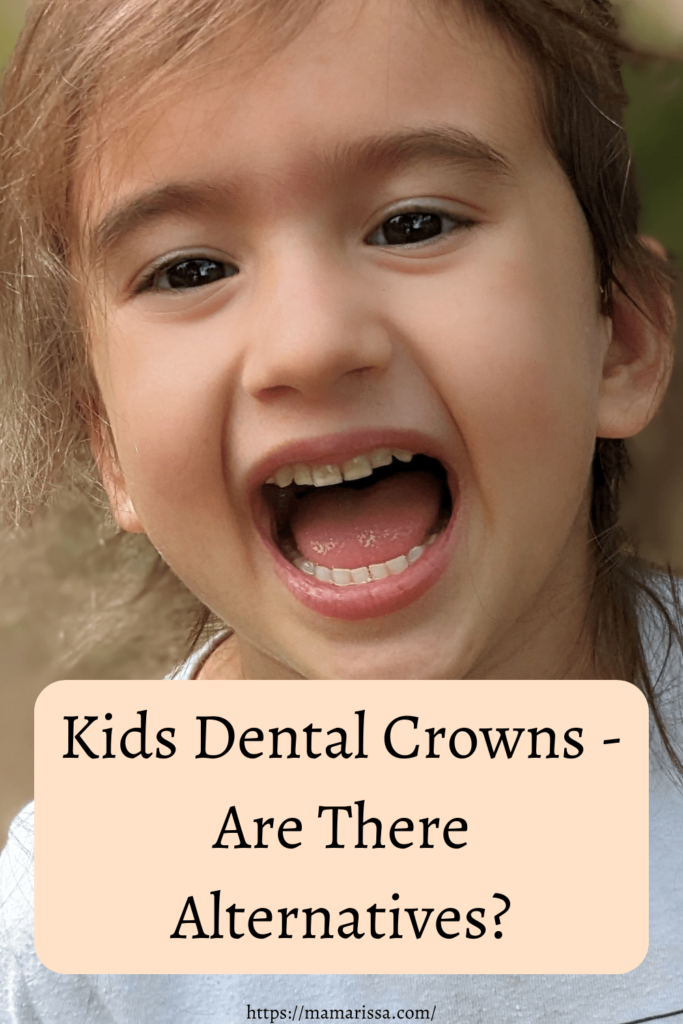
I hope that the information I share in this post will help you know that you are not alone, give you strength to do your own research on this challenging topic, and help you figure out what is best for your child.
DISCLAIMER: Please note that I am not a dental or medical professional and nothing in this post is meant to replace professional advice. Any practices or products suggested on Mama Rissa are meant only as the recommendation of a mom. It is the obligation of the reader to do his or her own research and speak with a doctor or dentist about any practices or products suggested on this website.
Hey Mama, if you find my blog posts helpful, would you help support this blog by making purchases through product links on this page? It will not cost you any extra but the commissions I receive as an Amazon and brand affiliate help to cover the costs of operating this blog so that I can keep it running ad-free. Thank you so much for your support. You are literally the reason this blog was started and the fuel that motivates me to keep it going!
To find a discount code for the ozone oil that stopped my daughter’s decay, click on the heading “Use Natural Topical Treatments to Halt the Decay” in the Table of Contents.
Table of Contents
- Making the Discovery
- Finding Your Options
- Choosing the Crowns and Fillings
- Living with the Results of Kids Dental Crowns
Making the Discovery
I get a lot of responses from my readers on my posts addressing childhood tooth decay. In fact, my most recent tooth decay post on 3 simple, natural treatments for childhood tooth decay has quickly become my most popular post.
Unfortunately, more kids than we realize develop cavities very young, some of which are quite severe before we parents even discover them. And many parents seek gentle or natural treatments for these cavities to avoid the risks of general anesthesia and having excessive dental work done on their little ones’ mouths.
Let me see if I can accurately describe what led you to this post …
It is a perfectly normal day tending to the needs of your toddler – feeding, bathing, playing – when he suddenly throws his head back and laughs, causing you to stare in shock. What are those black and brown spots on his back teeth???
You try to keep your tone light as you ask him to open wide for you again. When he refuses to allow your fingers inside his mouth, you tickle him into compliance to get another look at a horrific sight. Instead of the sparkling white teeth a healthy-eating toddler should have, you see various discolorations that clearly indicate something sinister is going on within your little one’s oral cavity.
In panic, you frantically snap a dozen pictures a second as you tickle your toddler’s mouth open again trying to get a clear shot to send to your spouse. You zoom in on the blurry images, mind racing as to what has caused this and what you did wrong. Your thoughts tumble over each other as you try not to cry, imagining your toddler losing his teeth, struggling to eat and having debilitating dental health issues for the rest of his life.
You quickly Google the closest pediatric dentist and call them with a shameful admission you are sure will have CPS at your door within the hour. The receptionist squeezes you into the day’s schedule and you load your toddler into the car for an emergency trip you never expected to be a part of your toddler mama experience.
At the dental office, the dentist peaks inside your toddler’s mouth, throws out some dental jargon to the hygienist to notate on a computer screen and then turns his attention to you.
“We’re going to need to get some x-rays to know the full extent of the decay, but I see four cavities on his back teeth and two on his front teeth. I would do crowns on all of them. We can do porcelain crowns on the front teeth for aesthetic purposes, but I would like to do stainless steel crowns on the back teeth because they will last longer. We have a great general anesthesiologist who comes in once a month to sedate young children such as your son while we do the work. The whole thing will take about an hour plus a little time for waking up from the anesthesia.”
The whole time the dentist is bombarding you with this devastating information, your mind is snagging on important, scary implications you refuse to accept: Six cavities. Crowns on all of them. General anesthesia!
Whew. I feel emotionally exhausted rehearsing that dental management plan I have listened to from multiple dentists I have taken my daughter to in the past three years. Let’s quickly get to some positive news, shall we?
Finding Your Options
Here’s the first bit of positive news I can confidently give you: You have more options than what the dentist is telling you. I am not going to promise you that you will not have to do any of what the dentist is recommending, but you do have options beyond the dramatic scene the dentist has painted for you.
Before I go further, let me clarify that I never advise ignoring medical/dental advice or refraining from visiting the dentist to figure out what is going on in your child’s mouth. What I do highly recommend is that you do your own research in conjunction with the information you receive from the dentist to determine the best treatment route for your child.

Now, let’s discuss all those options you have for addressing your toddler’s cavities.
Get a Second Opinion
I cannot stress enough how important it is to get a second opinion on what all needs to be done with your child’s teeth. But not just any second opinion. You need to get an opinion from a holistic or biological dentist if at all possible.
I have taken my daughter to five different dentists during her little life. Three were typical, conventional pediatric dentists. Two were biological or holistic dentists. And these are the differences I have experienced between to the two types of dentists:
| Conventional Dentists | Holistic/Biological Dentists |
| Give non-negotiable treatment plans | Make recommendations |
| Create urgency and pressure for the parent | Offer gentler solutions to help solve the problem |
| Use scare tactics | Provide options |
| Drill and fill ASAP mentality | Find the cause and only do the work necessary (and only when necessary) |
Let me first tell you about my experiences with conventional dentists.
The first time I took my daughter to the dentist after discovering her decay when she was two years old, I was told she would have to be put under general anesthesia and get several crowns and fillings. Oh, and I had to get her on reflux medication or else her acid reflux would just erode the crowns and fillings too.
Read here why I chose not to medicate my daughter’s acid reflux as a baby.
The second conventional dentist I took my daughter to was when she was 3 1/2 and we had just moved to a new state. I had not yet found a natural-minded dentist to take her to and her teeth had recently been hurting her, so I just took her in to a nearby pediatric dentist to get her teeth checked to see if the decay had worsened.
It was a very similar visit as the first time I took my daughter to the dentist a year and a half prior. Fortunately, based on what the dentist described of my daughter’s cavities, I knew that nothing had worsened in her mouth. The pain she was experiencing was simply from sensitivity.
Please note that I did not self-diagnose this pain. I had been told by both biological and conventional dentists that her pain was from sensitivity because cavitated teeth are more sensitive. If your child has pain, take her to the dentist right away as pain can be an indication of more urgent problems with her teeth.
The dentist insisted fillings and crowns were necessary, but when I pushed her for alternatives in order to delay getting the work done, I was amazed that she did indeed have an alternative available. Equally surprising, she admitted that my daughter’s teeth would be fine if we delayed the work as long as we kept the cavities from progressing (as we had already been successfully doing for the past year and a half …).
Mind you, this dentist was initially trying to push the crowns and fillings on me. She was not at all a natural dentist and never would have offered any alternative to getting the work done if it weren’t for the fact that I had played this game before and insisted we wanted to wait on getting work done.
The alternative she offered is called SDF – Silver diamine Fluoride. The benefit to this treatment is that it is much less invasive than getting crowns or fillings, but it protects the cavity from worsening as well as desensitizing the effected tooth. The downside is that it uses fluoride to do so and it also stains the tooth black.
We did not end up going the SDF route because I instead started using ozonated olive oil which greatly reduced her sensitivity. But we’ll talk more about that later.
Back to my experience with conventional pediatric dentists.
The third conventional dentist I took my daughter to was last June. For a conventional dentist, I actually really liked this one. But even he managed to instill fear and stress into my mind regarding the state of my daughter’s teeth. He pretty much refused to give her dental health the all-clear for starting kindergarten the next fall until he performed all of the work he felt needed to be done.
He even insinuated that we may be at risk of her teachers “reporting” us if they noticed her stained/decayed teeth. Note that I say stained/decayed because some of her supposed “decay” was actually just staining.
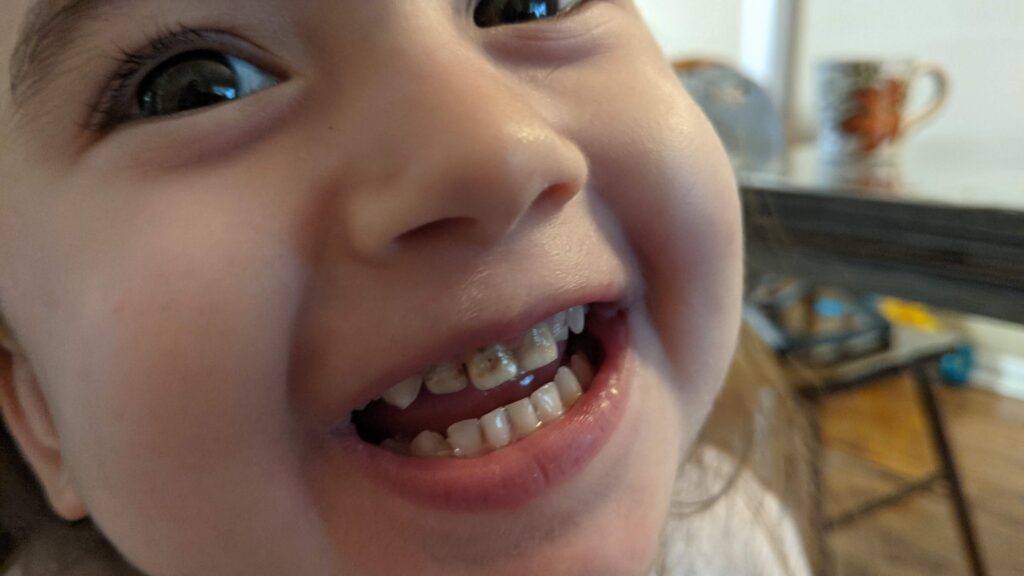
I left that appointment feeling like I had no options, honestly. Even though my daughter’s teeth were still doing just fine at that point (nothing had worsened on her affected teeth, she had no new cavities, and her sensitivity at that time was minimal), I felt trapped into having to get the work done before we were ready simply so she could get a form signed to be able to attend school.
Now let me tell you my experience with biological and holistic dentists.
We began taking my daughter to a biological dentist immediately after her first conventional dentist visit when I initially discovered her decay at two years old. We drove 3 1/2 hours every three months to take her to that bio dentist because we were determined to avoid putting our 2-year-old daughter under general anesthesia.
At that first bio dentist appointment, completely contrary to the scare tactics I have repeatedly experienced at conventional dentists, I was assured that things were not as hopeless as they seemed and we could indeed delay getting work done.
Read more on our encouraging experience at this biodentist in the second post I wrote on my daughter’s tooth decay here.
I was told by the dentist that we would eventually need to get some work done on my daughter’s teeth in order to protect their integrity because of how deep some of the cavities were. But I was not rushed to do so and was offered ozone gas treatments to protect her teeth from further decay in the meantime.
As a side note, this dentist told me upfront that he was not licensed to perform dental work under general anesthesia, so I knew he could not do the work and was not trying to sell me anything by saying she would need work done at some point.
The goal of the bio dentist and my husband from the start was to get my daughter to an age where she was either cooperative enough to get the work done without needing general anesthesia or old enough that risks of general anesthesia were reduced. To be honest, I always sort of hoped we would never need to get the work done, but the reality was that there was too much damage done before we even found the decay for it to be reversed.
My second positive experience was with a holistic dentist. As I mentioned previously, we moved to a new state a a year and a half ago and I had not found a bio dentist who would treat children. So for about a year, I took her to the two conventional dentists I have already described.
After I took my daughter to the conventional dentist in June (the one who warned me about her teachers reporting us), I felt like we would have to get the work done by the end of the year, and I wasn’t very happy about it since I saw no reason to do the work yet. Her teeth were not bothering her and we were using our natural treatments to protect them. And she was clearly not ready to sit still without general anesthesia to get the work done.
However, after our encounter with Covid in July, my daughter experienced an extended period of horrible gut problems including, among other things, the worst reflux flare up she has ever had. Those couple of months and the health and resulting behavior issues that went on during that time are a whole different post for another time.
And, boy, do I have a lot to tell on that unpleasant topic and the absurd medical advice we received. So check back for that – or better yet, sign up for my email list so you will know whenever I publish a new post.

Anyway, as a result of her severe acid reflux during that time, her teeth became extremely sensitive. Despite limiting acidic and sugary foods and using our natural treatments, her teeth continued to be painfully sensitive, and it was only adding to the discomfort she was already in from her other Covid-triggered health issues.
It was at this point that we felt getting the work done on her teeth was truly necessary. We did not know how much longer we would be dealing with her severe gut issues and the consequent tooth sensitivity, and we knew it was the right time to get them fixed.
However, my husband and I went through no small amount of anxiety during the course of getting her dental work scheduled. We were really nervous about the fact that the conventional dentist I had taken her to in June wanted to put five crowns on her teeth. This sounded ridiculously excessive and we were not convinced this was necessary.
The dentist claimed that even the less severe cavities on the back of her front teeth needed crowns because those teeth would flex and fillings would just pop out.
So I searched and found a holistic pediatric dentist a half hour away and took her there for a second opinion. I am going to greatly abbreviate the process of decision-making we went through and just tell you that we went with the holistic dentist to get the work done and my daughter ended up with two crowns and two fillings – instead of five crowns.
Edit: If you are looking for a holistic dentist to take your child to, try searching a database such as the International Academy of Biological Dentistry and Medicine, the International Academy of Oral Medicine and Toxicology or the Holistic Dental Association.
The holistic dentist explained that fillings on the front of front teeth will pop out but it should not be a problem on the back of the front teeth (my daughter had a lot of staining on the front of her front teeth – perhaps the conventional dentist assumed these were cavities). She did not feel crowns were necessary on the front teeth unless the cavities wrapped around the sides of the teeth, and, fortunately, my daughter’s did not.
The dentist did scrape some of the staining off of her front teeth so that they do not look as brown now, but the active decay that used to be happening on those front teeth stopped when we started our natural treatments at the beginning of this journey. I believe the natural interventions we took prevented her from needing more extensive work done on those front teeth.
I really appreciated that this holistic dentist did not try to scare me into getting the work done. She had a very relaxed manner and basically told me what she thought needed to be done – which was way less than what the conventional dentist thought needed to be done – but made it clear that the decision was up to me.
At this point, we knew we needed to just get it all taken care of so we did. My daughter still needed general anesthesia, but I felt so much more comfortable with her being put to sleep as a 4 1/2 year old than I did when she was two.
She was also much more emotionally ready for the process of being led away from me to be put to sleep. At her current age, she was happy and confident and smiling as she walked away with the anesthesiologist. When she was two, she would have had to have been ripped out of my arms screaming and crying, which would have been traumatic for both of us. I was endlessly grateful through the whole experience that we had been able to wait as long as we did to get her teeth worked on.
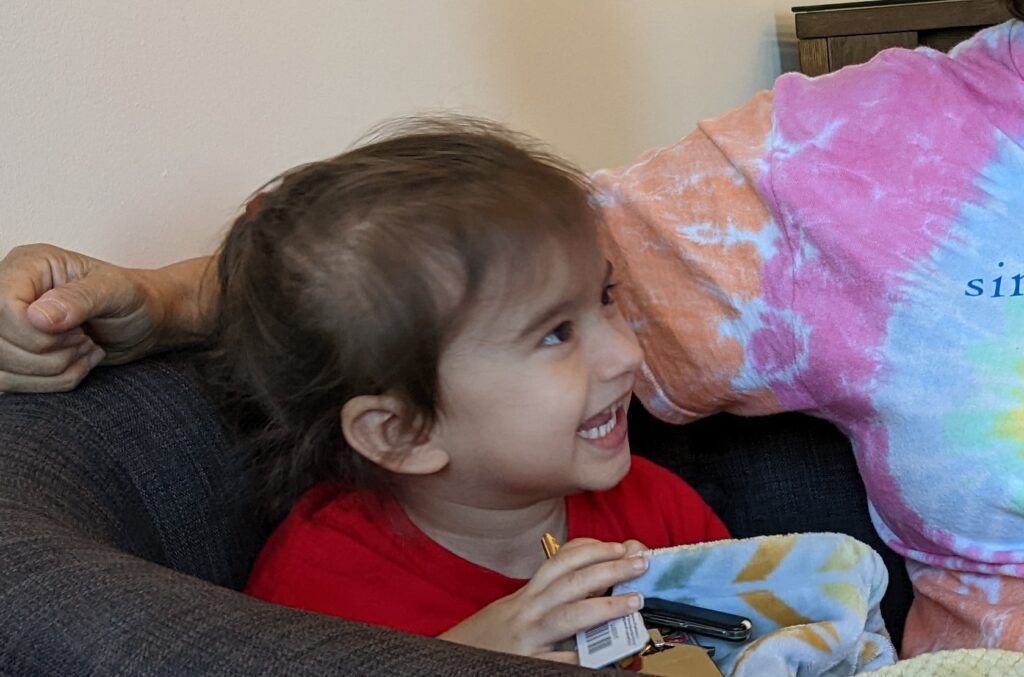
Which brings me to the next option you have.
Delay Crowns and Fillings if Possible
Some children with cavities will not actually need any work done on their teeth. It is entirely possible to completely heal surface cavities with natural home remedies depending on their severity. Just check out this post over at Raising Natural Kids to see how Dawn Lorenz naturally healed her daughter’s cavities.
Because some cavities can indeed be healed with natural home treatments, it is a good idea to try not to rush into getting fillings for your child as soon as the dentist mentions a cavity and recommends a drill and fill. It may not even be necessary at all.
Unfortunately, as in my daughter’s case, it is not always possible to completely avoid getting fillings and crowns because some cavities are too far gone before we know to begin natural treatments on our kids’ teeth.
It is important for you to figure out if fillings and/or crowns are truly necessary for your child. There are two ways for you to figure this out. First, go to a biological or holistic dentist who will give it to you straight. Second, unless there is clearly an emergency indicating that the work urgently needs to be done (like a broken or chipped tooth, nerve pain, abscesses, etc.), try to put off getting the work done, at least for a month or two and see what happens after some natural treatment.
If the cavity is unchanged, you may have a little more time to try to heal it naturally. If it is better, you are obviously headed in the right direction and may be able to avoid getting any work done. If it is worse, you know it is likely going to keep deteriorating until you take more drastic action.
In my daughter’s case, her cavities stopped deteriorating as soon as we started our natural treatments, but they were too deep for the body to naturally restore. If this is the case for your toddler, you may be able to at least delay getting the work done until she is older (but please consult with a holistic dentist on this regularly to make sure this is a healthy option for your child).
And how to stop the progression of the decay in order to delay (or completely avoid) more invasive treatment is the topic of the next couple of options you have at your disposal.
Use Natural Topical Treatments to Halt the Decay
There are so many natural substances that can be used to fight tooth-destroying bacteria, but I’m going to limit this discussion to the two main topical treatments I have used successfully with my daughter.
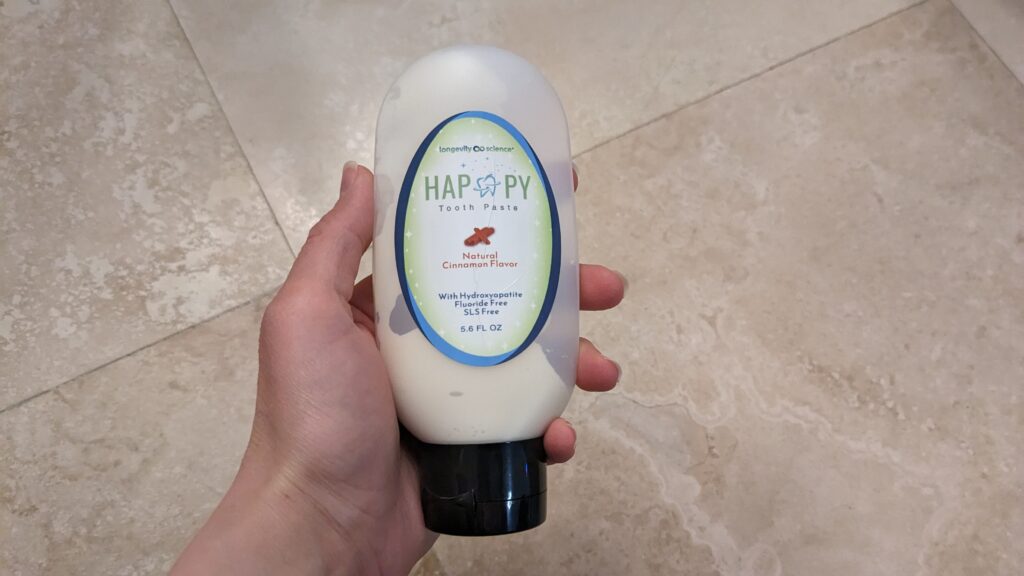
The first thing you need to do when discovering decay in your child’s mouth is find a good, natural, safe-to-swallow toothpaste. You want a toothpaste that is going to not only kill bad bacteria but protect your child’s demineralized, vulnerable teeth.
Hint: You will not find this toothpaste on the shelf at Walmart.
You will likely have to order something online, and I’m not going to lie, it’s not cheap.
As a more affordable option, if you are willing to do the research on what is safe and necessary for your child’s teeth, there are tons of recipes online for making your own natural toothpaste. I initially began my daughter’s oral health recovery journey by looking at different toothpaste recipes, but I did not feel confident in my own abilities to know exactly what ingredients in what proportions needed to go into my daughter’s toothpaste to yield optimum results.
So I began researching natural toothpastes online. There were several that looked pretty promising, but I ended up going with Happy toothpaste by Natural Tooth Health (please note, this is NOT the same as Happy Teeth toothpaste).
I chose this brand because of the complete, clear list of ingredients on the website detailing where each ingredient comes from and why it is used in the toothpaste. You can read the full ingredient descriptions on the Natural Tooth Health website here.
Personally, I felt every single ingredient was justified and safe based on the explanations given. I could not say that with certainty about the other options I looked at. Notably, this toothpaste is also safe to swallow and is verified by the EWG (Environmental Working Group).
Additionally, Happy Tooth Powder products have been through two different studies proving their ability to effectively protect teeth as well as or better than other toothpastes.
The first is a study from 2018 which measured how abrasive the toothpaste is and how well it cleans. This study (which you can read more about on the Natural Tooth Health website here) placed Happy toothpaste among the top two out of 26 toothpastes for being minimally abrasive to dentin while being extremely effective at cleaning stains and plaque off of teeth, scoring significantly better than several commercial brands including Crest, Sensodyne and Colgate.
The second study was just completed in 2022 and measured how well Natural Tooth Health products prevent demineralization and remineralize teeth. The study revealed that Happy toothpaste and tooth powder prevent demineralization and cavities better than fluoride toothpaste and remineralize teeth just as effectively as fluoride toothpaste.
This study has not yet been published on the website, but I will update this post with a link once it is.
Personally, I have been using this Happy toothpaste with my daughter for the past 2 1/2 years and believe it has majorly contributed to her improved oral health, so I cannot recommend it enough.
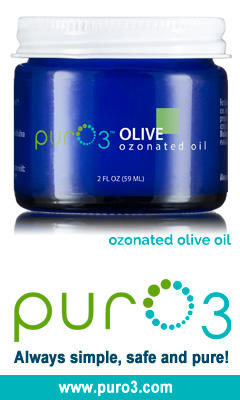
Ozonated olive oil is a great way to quickly kill off the bacteria attacking your child’s teeth. Without getting into the science of it (because I am not a science person), suffice it to say that ozonated gas, water, or oil kills bacteria with very little risk of adverse side effects.
While there are not a lot of quality studies currently on the effectiveness of using ozone on tooth decay specifically, it is known to break down the walls of bacterial, viral and fungal cells and has been shown to be effective at curing oral candidiasis and oral lesions and even preventing relapse in cancer patients, among other things.
From my personal experience with my daughter’s teeth, I can say that ozone has been effective at helping with both alleviating tooth sensitivity (until we had the post-Covid reflux flare-up that was constantly bathing her teeth in acid) and eliminating inflammation in her gums.
You need to make sure you get a good quality ozonated olive, sunflower or hemp oil. The one I link to here is a good quality olive oil that was recommended to me by my daughter’s previous biodentist. For a good description of what to look for in a high quality ozonated oil, take a look at this article.

Some other natural topical treatment options you can look into for inhibiting bad bacterial growth in your child’s mouth include coconut oil, aloe vera and xylitol (which is one of the ingredients in the orange cream flavor of Happy toothpaste, by the way).
Diet Changes and Vitamin Supplementation
I know some natural mamas might argue that diet and vitamin discussion should happen before the bacteria killing topical solution discussion. But, while I completely agree that getting to the root of the problem and addressing nutrient deficiencies is very important, it takes longer to implement and see results from those kinds of changes. If your child has tooth decay, you need to stop the decay from worsening as soon as possible and then work on long-term tooth health improvement.
Having said that, there are a variety of ways in which you can address the diet and vitamin deficiencies that may be effecting your child’s teeth.
A lot of anecdotal stories show success following the Weston A. Price diet which focuses on eating organic, grass-fed meats; wild-caught fish; organic, grass-fed animal fats; bone broth; cod liver oil; soaked or sprouted grains, nuts, seeds and legumes; fresh vegetables and only natural sugars. You can read about the diet in more detail on the Weston A. Price Foundation website.
You can also check out my original post on childhood tooth decay for more info on reducing phytic acid consumption (phytic acid blocks nutrient absorption) which is the reason behind soaking or sprouting grains, nuts, seeds and legumes.
Another way to approach altering or improving your child’s diet is to find out if he has any bacterial overgrowths that are inhibiting nutrient absorption. You can see a naturopathic doctor for this if that is in the budget for you.
If it is not in the budget for you, there are stool test kits you can order to do at home and mail in to get results. We did this with my daughter when she was struggling with obvious gut health issues after Covid. We already knew she had a candida overgrowth from plaque samples the bio dentist examined under a microscope (again, you can read more about that in my second post on childhood tooth decay), but getting this comprehensive stool analysis was really helpful for understanding more about her microbial health.
If you want to invest in a really good stool test kit, this GI-MAP test is the one we used. This stool test is comprehensive. It covers a range of different areas of the microbiome including pathogens, good and bad bacteria, viruses, fungi, yeasts and parasites. It is actually a medical quality test that is meant for practitioners to use, but anyone can purchase it through YourLabWork.com.
While this test is not cheap, it is extremely helpful and far more informative than what the typical doctor will be able to tell you about your child’s unexplained health problems, especially gut issues. I was amazed at how in-depth it was. In contrast to the stool test my daughter’s GI doctor ordered on her that came back with a vague “normal” result, the detailed report I received from doing this stool test gave me so much more insight into what is really going on in her gut.
If you would like a preview of what the test analyzes, take a look at the Interpretive Guide that helps you understand the results.
As a side note, if you do order a stool test through YourLabWork.com, just note that you have to put your own name on the order rather than your child’s because the person ordering must be at least 18 years old.
It may not be necessary to get a stool test in order to address nutrient issues that are causing tooth decay for your child. But it is definitely helpful to know if your child has one or several bad bacteria overgrowths or good bacteria deficiencies since these imbalances can hinder nutrient absorption.
Bacteria could also be traveling up from the gut into the mouth if your child has acid reflux like my daughter. In this case, the gut bacteria issues, combined with the acid from the stomach, may be part of the cause of the decay. This study demonstrates the differences in the oral bacteria of people with acid reflux (GERD) and those without acid reflux.
It is also important to note that oral bacteria can travel to and cause disease in the gut. This article is a quick read that cites some studies showing this. Because of this relationship, children with oral bacterial issues could develop gut bacterial issues.
So whatever the relationship (gut-to-mouth or mouth-to-gut), it is a good idea to pay attention to your child’s gut as well if he has tooth decay.
In my daughter’s case, in addition to several bad bacteria overgrowths, we found that she is deficient in an important good bacteria which aids in protecting the gut’s barrier to prevent toxins from leaking into other parts of the body (you may be familiar with this as leaky gut). If toxins are leaking outside the gut, they are going to affect many other areas of the body, which could also end up affecting the teeth.
Even if you do not do any testing for bacteria overgrowths, limiting carbs and sugars (even natural ones) is one of the ways to help your child’s cavities heal. If there is one thing dentists across the board agree on, whether they are conventional or natural, it is that kids should not be sipping on juice all day, eating sugary foods regularly and snacking frequently on carbs. Feeding the bacteria that is working against your child’s tooth health is obviously going to exacerbate the problem.
Another way to address nutrition and vitamin deficiencies is to simply supplement with vitamins. But you will have to be on your guard while researching vitamins. Most children’s vitamins contain sugar, and even though it may seems like a small amount, chewing on sugary vitamins is going to do more harm than good for your child’s teeth.
Personally, I have often come to the conclusion that the best way to get good quality vitamins into my daughter without the sugar is to buy vitamin capsules, open them up, dump out the powder and mix it into her food. Some vitamins can also be purchased in a tasteless liquid form that can be added to water.
I’ll just give you a list of the vitamins and supplements I have used in the past or currently use to help boost my daughter’s tooth health and also her gut health (which, as I already mentioned, can affect nutrient absorption and tooth health).
Collagen is good for helping repair the gut. I use the Mama Natural brand because it contains six types of collagen (most contain three or four at the most), which means more parts of the body are benefiting from it.
I will just say that I noticed a very obvious improvement in my daughter’s health in a particular area when I started mixing this into her water everyday. She had been complaining of her legs hurting for many months and within a very short time of starting the collagen, she never complained of leg pain again (until her gut was majorly altered by Covid, but the leg pain is improving again since her gut health has begun to improve over the past few months).
Make sure you adjust the dose for your child. I only use about 1/2 – 3/4 teaspoon a day for my daughter.
- Bee Propolis
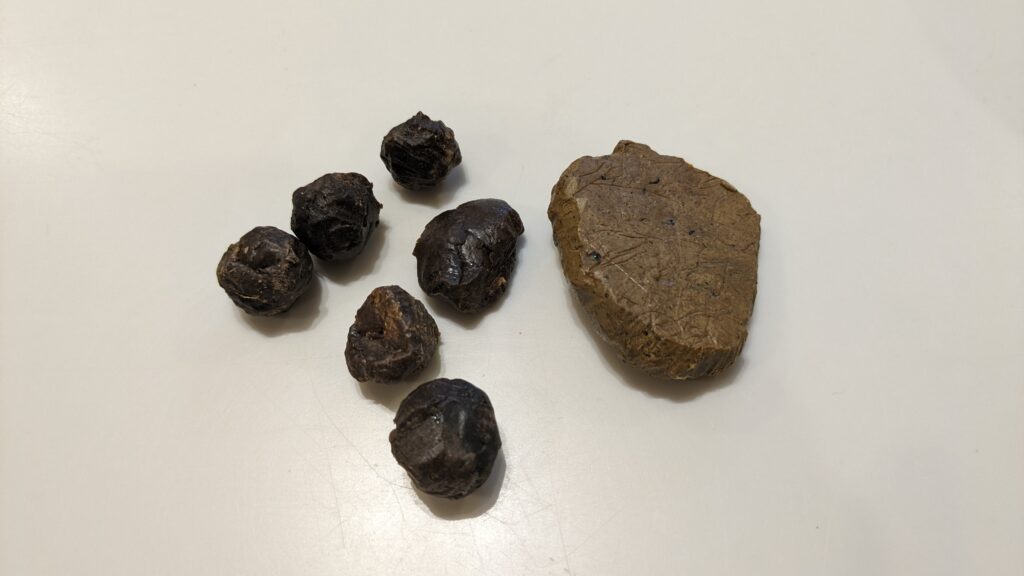
Propolis is a part of the structure of a bee’s hive and is used to help waterproof and protect the hive from various invaders. It is known to be an effective antimicrobial, antifungal, and antibacterial. It has been shown to inhibit the growth of candida and according to this article, it was proven to be more effective at treating caries (cavities) than routinely used anti-caries agents in India because it also inhibits the growth of streptococcus mutans (one of the main bacteria responsible for causing cavities).
You can purchase propolis in a variety of forms including powders, liquids and solid chunks. The picture above is of two different kinds of chunk propolis I have and use for my daughter. the darker pieces were sent to us from a family member overseas and the lighter, larger chunk was ordered from a bee keeper in the U.S. via Ebay.
I simply carve roughly 10-20 sesame seed-size pieces of this onto my daughter’s breakfast every morning. She doesn’t usually even notice it’s there. It does have a mild taste, but you cannot taste it when using that small of an amount mixed with food.
Once again, this is a supplement that produced an obvious change in my daughter’s oral health. After we began using propolis regularly, my daughter’s chronically white tongue (from her candida overgrowth) disappeared!
I no longer use these for my daughter because I am currently focusing more on her gut health than just strictly her tooth health. Instead, I currently use a broader multivitamin for her along with probiotics and prebiotics (listed below).
However, I initially really liked this vitamin because it was an easy way to get some tooth-specific vitamins into her and they tasted good without using sugar. They are sweetened with xylitol which is actually beneficial for teeth and kills candida. Also, in my and my daughter’s opinions, xylitol has a taste and texture very similar to sugar and does not have the aftertaste that most sugar-substitutes have. So my very picky daughter actually loved the taste of these vitamins.
- Vitamin K2
In conjunction with the Animal Parade tooth vitamins, I also previously used Mary Ruth’s Organics Vitamin K2 liquid drops. I am not going to link to those here because I have recently seen a few too many reviews about concerning quality issues with some of Mary Ruth’s other liquid vitamins.
From my initial research, I found that vitamin K2, vitamin D and calcium all work together to support and restore bone and tooth health, so I knew I needed to have a vitamin K2 supplement to go along with the Animal Parade vitamins (which contain vitamin D and calcium but no vitamin K2).
More recently I discovered this article by a functional dentist that explains his take on what causes cavities and how vitamin K2 can play a role. It is quite interesting if you want to do more reading on the topic.
The Weston A. Price Foundation is also a big proponent of vitamin K2 and the prescribed diet is heavy in vitamin K2 consumption. So you may also want to check that out if you didn’t earlier to see how you can naturally increase your child’s vitamin K2 through foods.
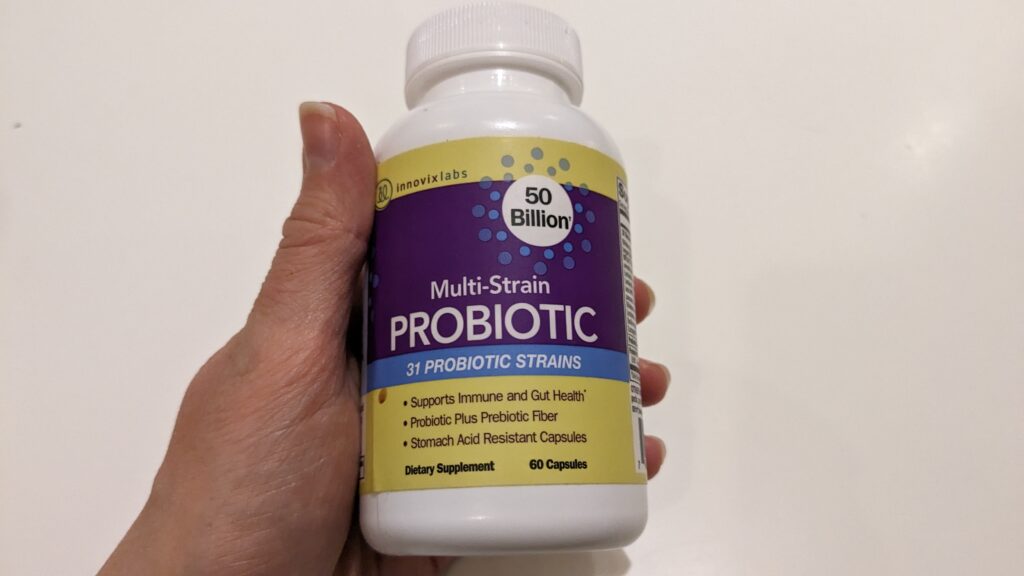
After we received my daughter’s stool test results and associated recommendations several months ago, I went on the hunt for a high-potency, mega dose probiotic that contained the specific strains that were recommended for her bacteria imbalances. This probiotic is what I ended up getting. It is manufactured in the U.S., the probiotics are cultivated in the U.S. and Denmark, and it contains 31 probiotic strains.
Now, I’ll be honest. This kind of probiotic is exactly what my daughter needed and it seems to be helping to improve her gut. Your child may not need this exact same thing or this high of a dose. But it is still a great probiotic because it is so diverse with how many strains it has. So if you do not know what specific probiotics your child might need, this is probably a good option to cover a lot of basis.
I initially gave my daughter two capsules a day, but again, your kid might not need that much if she is not having any major gut issues. Just open the capsule and sprinkle however much you want to use onto some food for your child (make sure it’s not hot food so you don’t kill the probiotics). Similar to the propolis, the probiotic does have a mild taste, but as long as it is mixed into food, my daughter cannot taste it.
Edit 3/28/2024: I recently emailed Innovixlab to inquire about third-party testing of this probiotic. In response, they sent me a document certifying that the lot tested was manufactured according to the FDA’s Good Manufacturing Practices. Simply put, the certificate showed that this probiotic contains everything it says it does and none of the bad stuff that it should not – which is very good and reassuring!

I mentioned earlier that my daughter is severely lacking an important bacteria for protecting the gut barrier. This Fructooligosaccharides (FOS) prebiotic powder is the specific prebiotic she needs to help restore that bacteria. However, prebiotics are also just good in general because they feed probiotics and help regulate bowel movements.
I used to use this acacia senegal prebiotic fiber for her and it initially seemed to help with constipation. But after Covid, she was having frequent issues with constipation even while using the acacia senegal. Once we did the stool test and I did some research, I realized that she specifically needs FOS prebiotic and she has not been constipated since I started giving it to her.
You can get this FOS prebiotic powder on Amazon here or from IHerb here.
Once again, the reason I am telling you this in a post about tooth decay is because a leaky gut can cause other problems in the body. And this prebiotic is one of the solutions I have found for my daughter to help with her leaky gut. If you have no reason to suspect your child has a leaky gut, then you may not need to use a separate prebiotic because a lot of probiotics contain a small amount of prebiotic to feed the probiotics.
So unless your child is desperately in need of a higher dose of prebiotics, you are probably fine to just get a probiotic, making sure it contains a prebiotic.
Get the Work Done By a Holistic Dentist
And finally, going back to my first point of getting a second opinion, please know that even if you have to get work done on your toddler’s teeth and even if it cannot be delayed, it does not have to be done by the first dentist you take your child to.
Find someone you are comfortable with doing the work. Find someone you trust to only do what is necessary and not be excessively eager to add prosthetics to your child’s natural mouth. Find someone who you truly feel wants to do what is best for your child’s specific needs rather than meet quotas or make a certain dollar mount on fillings and crowns this month.
As I said before, I believe the best way to accomplish this is by going to a holistic or biological dentist if possible. Even if you will not be using that dentist for regular check-ups because of cost or distance, at least try to get the work done by a natural, low-intervention dentist.
That is what I am doing with my daughter. Although I went with the holistic, out-of-insurance-network dentist who is a half hour away for getting the fillings and crowns, I am taking her to the conventional dentist five minutes down the road who is in-network with our insurance for her regular check-ups and cleanings.
By the way, as a side note, carefully consider costs when it comes to holistic and biological dentists. Despite the fact that my daughter’s holistic dentist was out-of-network with our dental insurance, the cost of the work we had done ended up being very close to the cost it would have been to go with the in-network conventional dentist.
There are a couple of reasons for this. First, neither of the anesthesiologists were in-network with insurance regardless of whether or not the dental offices were (apparently no dental anesthesiologists in our area work with insurance, because I found this same situation when I called around to different dentists), and the anesthesiologist working with the holistic dentist was actually a lot cheaper than the one working with the conventional dentist.
Oh, and sub-side note here: You will need to look into whether the anesthesiologist portion of the bill needs to be filed with dental or health insurance. Where I live, it can be different depending on the child’s age and special circumstances and also may or may not be covered based on those things.
Another reason the holistic dentist was around the same price is because, even though the work being done was more expensive per crown, my daughter was getting significantly less crowns put on at the holistic dentist and had fillings (which are cheaper than crowns) in place of some of the crowns the conventional dentist wanted to put on.
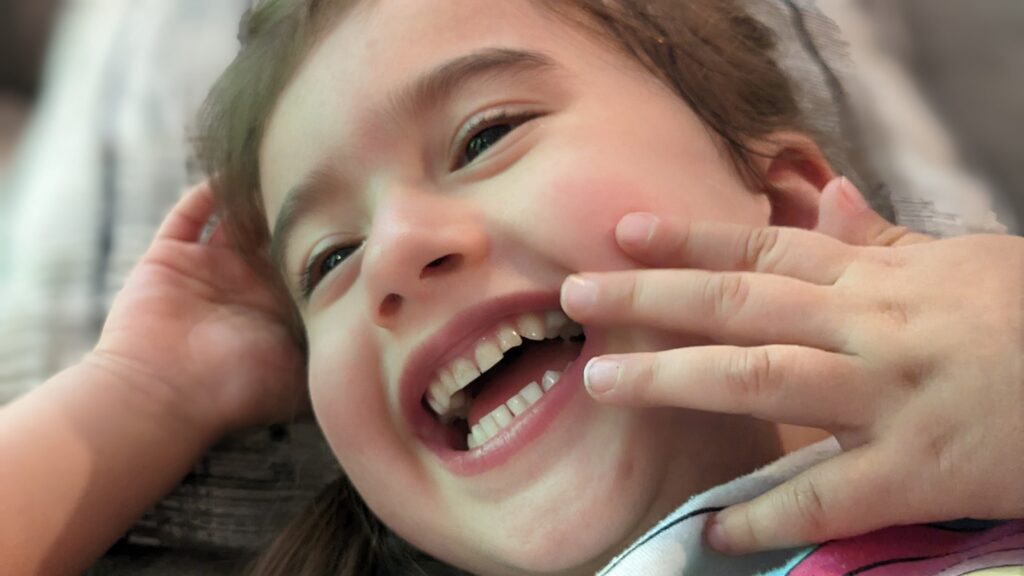
So we could have ended up paying close to the same price to have more work and intervention on my daughter’s teeth. Normally, buy more, save more sounds good, but when it comes to unnatural and unnecessary interventions on my daughter’s health, I’ll pay the same price for less work any day.
Choosing the Crowns and Fillings
And finally, if and when you do indeed end up deciding that kids dental crowns (and/or fillings) are necessary for your little one, you will need to figure out what options are available to you in terms of the material used. Once you know your options, make a decision on which type of crown/filling you want used on your child’s teeth (this will also depend on the options your child’s dentist offers, of course).
Honestly, when we were making this decision with my daughter, I was going through a very stressful time with her health and behavior issues, a new pregnancy, and very little sleep as a result of both. Consequently, I did not do much research on which types of materials are best, healthiest, safest, etc. for use as oral prosthetics. It simply was not in my capacity to do so and we needed to get the work done ASAP.
Also, when I did try to do a bit of quick searching on what types of crowns are best and safest, I found the information conflicting and confusing. So for your benefit, Mama, I have done a little more digging for this post to find out what the best, healthiest and safest options are. I am going to lay it out as simply as possible so you have all the info in one place.
Metal Dental Crowns and Fillings
The most durable kids dental crowns and fillings – particularly for molars – are metal. They are more likely to hold up to teeth grinding or a bump to the mouth. They may also last longer than other types of crowns and fillings because they don’t wear down as fast.
However, they are not without their own issues. Metal implants react to temperature changes more than other types of implants which means they will contract and expand. This can potentially cause separation between the crown or filling material and the natural tooth and even cracks in the natural tooth.
In terms of safety/health concerns, most sources agree that the amount of metal that implants expose the body to is not enough to cause toxicity. But it is clear that metal dental implants do release metal compounds into the body. This study evaluated the effects of putting metal crowns on extracted molars by testing the amounts of nickel, chromium and iron found in the roots of these teeth compared with the roots of uncrowned extracted molars.
The results showed 5-6 times higher concentrations of these metals in the roots of the crowned molars versus the uncrowned molars. Essentially, this means that the metal from metal dental crowns definitely leaches into the roots of the teeth and, presumably, the rest of the body.
Even though the amount of metal released into the body may not be enough to become toxic on its own, some people have or develop allergies or sensitivities to metals and can have negative reactions to their metal dental implants. This may or may not be a problem for your child, but it is certainly something to keep in mind.
One metal you definitely do not want in your child’s mouth is mercury, also known as amalgam. This is often found in silver dental implants. Mercury is indeed toxic and should be avoided. Some holistic dentists even emphasize removal of amalgam fillings and crowns as one of their services.
When considering metal kids dental crowns or fillings, you are obviously also going to need to consider the aesthetic aspect. Even on molars, the metal is going to show occasionally (like when your child laughs, which is pretty often for most kids). You may not mind this, and if you don’t, metal may be the best option for your child’s molars.
Personally, my husband and I felt strongly that we did not want metal crowns even on our daughter’s molars because we don’t want other kids (or even adults) noticing or commenting on them for her sake. When my daughter throws back her head and laughs, it gives me comfort to know that no one can tell that she has had to have dental work done.
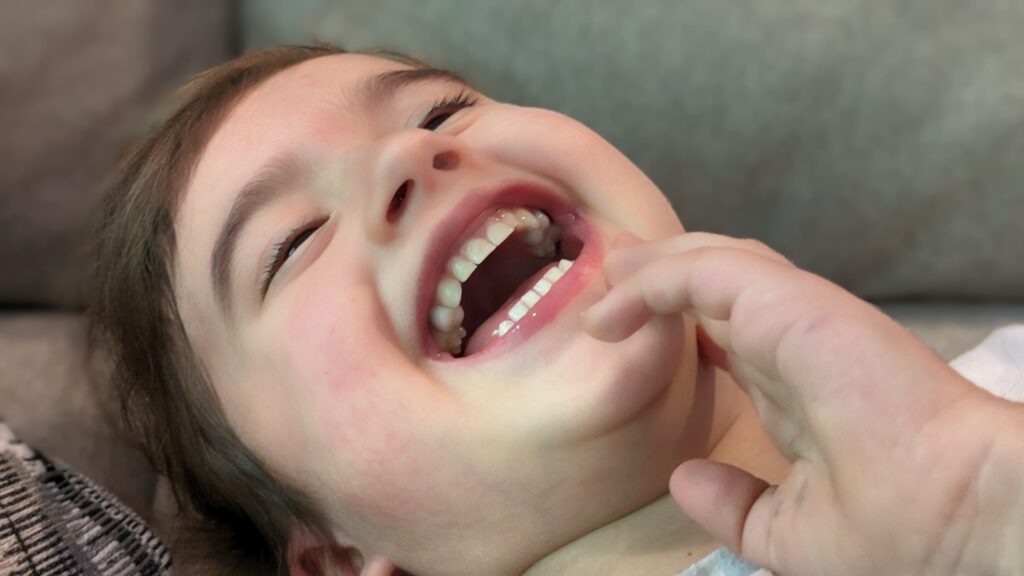
Ceramic/Porcelain Dental Crowns and Fillings
If you are like me, you are wondering what the difference is between ceramic and porcelain crowns. This article cleared things up for me nicely. Basically, porcelain is just a specific kind of ceramic that is used for making crowns. The term “ceramic crowns” is generally referring to porcelain crowns.
As the article explains, when you see porcelain crowns contrasted with ceramic crowns online, the “porcelain” crowns being referenced are likely porcelain-fused-to-metal (PFM) crowns which are porcelain covered metal crowns. PFM crowns provide the extra strength of metal while allowing for the aesthetic appeal of tooth-colored porcelain.
Ceramic crowns and fillings are not as strong as metal and generally will not last as long or hold up to as much pressure and wear as metal. However, they are often preferred for front teeth for aesthetic purposes and they are a safer option for people who may already have or want to avoid developing a metal allergy.
Another tooth-colored crown option is zirconia. Zirconia crowns are basically an extra strong type of ceramic according to Healthline, which also states that zirconia crowns are superior to other ceramic crowns in a variety of ways. Zirconia crowns have the benefit of longevity, lasting as long as metal crowns without the risks of allergic reaction. Zirconia crowns are also less likely to wear down counter-teeth than other forms of ceramic.
The downside to zirconia crowns is the cost. They are more expensive than metal and ceramic/porcelain crowns.
Zirconia crowns are what we ended up going with for my daughter’s molars. The holistic dentist who did the work offered stainless steel and zirconia crowns but warned that zirconia was more expensive. They were indeed more expensive, but I am so glad we went with them. Knowing that they are durable, biocompatible (unlikely to cause allergy or sensitivity), and natural in appearance is completely worth the price considering she will have these teeth for potentially another seven years.
This article contains a brief but informative explanation of zirconia crowns compared to PFM crowns if you want to look into this type of dental crown further.
Resin/Composite Fillings
Resin or composite fillings are the preferred option for front teeth because they are tooth-colored. They are more expensive than metal fillings, but they could also be safer than metal fillings since they do not carry the same level of risk for allergic reactions.
However, Rejuvenation Dentistry warns that you need to ask questions about what your dentist’s resin/composite fillings contain to be sure they are safe. Resin/composite fillings should be free from harmful chemicals such as Bisphenol A (BPA), 2-hydroxyethyl methacrylate (HEMA) and bisphenol A-glycidyl methacrylate (bis-GMA). Rejuvenation Dentistry also recommends seeing a bio dentist as they will be more likely to ensure their fillings do not contain these chemicals.
Another downside to resin fillings is the fact that they do not last as long as metal fillings. While metal fillings are supposed to last at least 10-15 years, resin fillings are supposed to last at least five years. This may not be much of an issue for baby teeth, however, since they will potentially be lost before the filling would need replacing anyway (depending on which tooth is being filled and the age of the child).
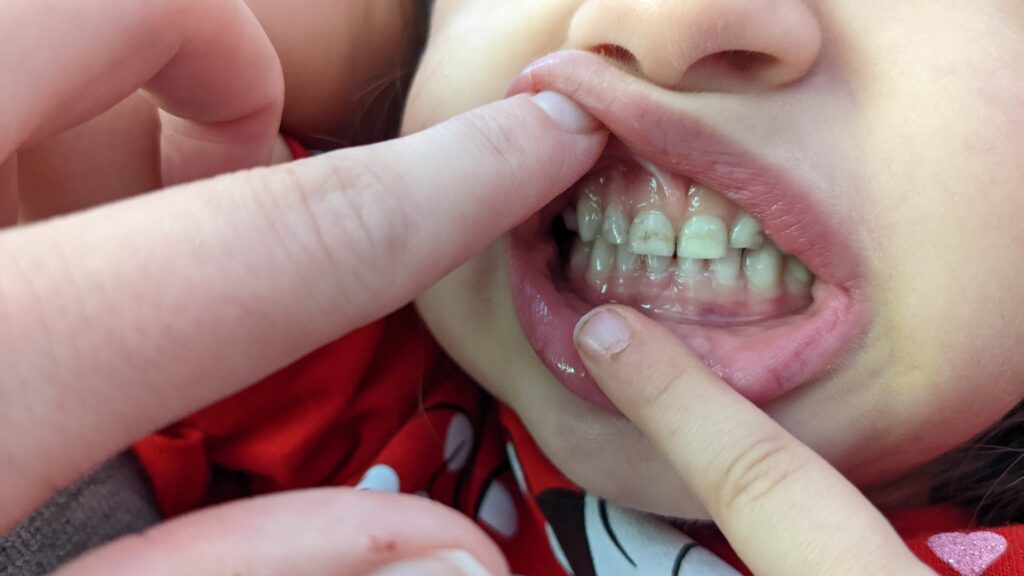
My daughter got a couple of resin fillings on the back of her front teeth. The bio dentist was not concerned about their life-span. My daughter will lose those teeth long before there is any concern over them wearing down.
Glass Ionomer Fillings
Glass ionomer fillings are made from acrylic and a glass material according to WebMD. Glass ionomer fillings are not very strong and do not have a very long life, so they are primarily used on baby teeth on areas that are not biting or chewing surfaces (like the sides of teeth).
Also, something to keep in mind is that this type of filling releases fluoride, so these are not a good option if you are trying to go natural and avoid fluoride.
Living with the Results of Kids Dental Crowns
To wrap up this unbelievably long post on kids dental crowns (God bless your perseverance if you have stuck with me this long), I just want to briefly tell you how I feel about my experience with my daughter’s tooth decay journey and ultimately getting dental crowns and fillings.
First, I will say it has certainly been a journey. There have been moments of panic and moments of huge relief. Moments of intense mom-guilt and moments of joyous victory. And it’s not over. I still watch over my daughter’s teeth pretty carefully to make sure there isn’t any new decay forming or problems with her crowns.
However, I feel that the hardest part of the journey has finally come to an end. We did what our original goal was. We got her to an age where we felt much more comfortable with her having the work done and going under general anesthesia. We prevented her decay from worsening for two and a half years and even improved some of it – which I believe prevented her from needing more work done than she ended up needing in the end.
And overall, I am very happy with how everything turned out as a result of our efforts. I can honestly say at this point that it is a relief that she got those crowns last fall. I could not have said that when she was two. But right now, I know that we are not just covering up a problem that will resurrect itself because we didn’t get to the root of it.
I also did not feel crowns were necessary at the young age of two with the effective natural treatments we were using, but I did feel they were necessary when we got them at the age of 4 1/2. Not because her teeth were in worse shape – on the contrary, they were actually in better shape – but because of the severe sensitivity she had developed from her severe reflux.
Since she had crowns put on, my daughter has not complained of her teeth being sensitive or hurting once (except for the initial few days after having them put on, which is a normal reaction to messing with the teeth). And that fills me with gratitude. It brings me so much peace to know that she’s not going to have tooth pain whenever she has a reflux flair-up or eats lemony fish.
The best one sentence summary I can give you of how I feel about my daughter’s tooth decay and her resulting crowns is this: I am so glad we waited to get crowns and found natural solutions to her decay and I am so glad we got the crowns when we did.
My last piece of advice to you, Mama, is this: The answer to your child’s cavities is not simply whether or not you should agree to having kids dental crowns put on. Even if it is the right time for you to get the work done on your child because the damage is just too great or causing pain, it is still important that you find ways to improve his oral health.
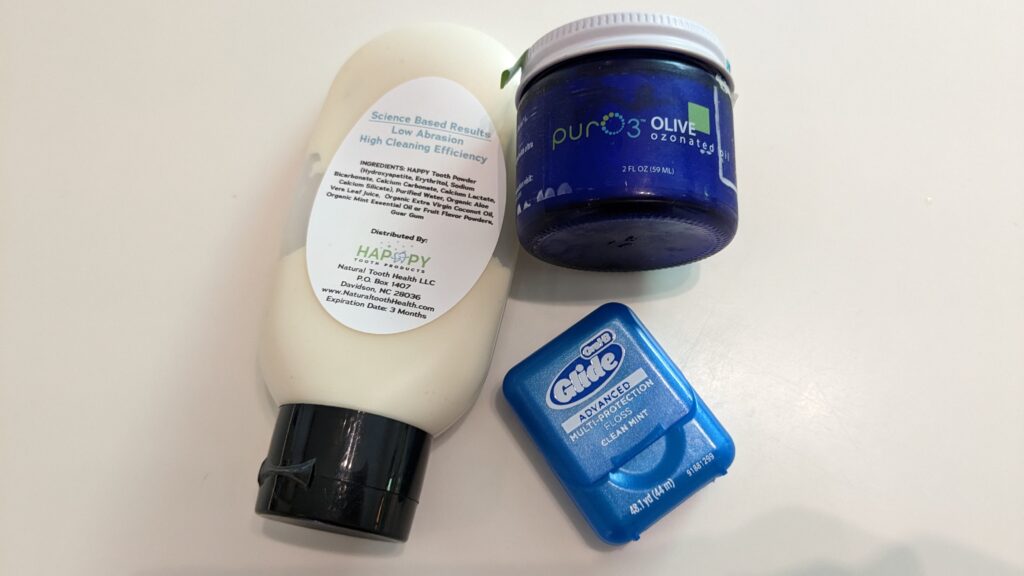
Kids dental crowns don’t fix the microbial and demineralization problem happening to your little one’s teeth. They simply put a physical barrier on the teeth that have been too damaged to function well on their own anymore. Unfortunately, your job is not done just because you get those crowns and/or fillings.
So whether you are trying to delay getting the work done or you know it has to be done now, all of the information in this post is relevant to you. Keep doing your research, keep talking to your pediatric dentist (preferably holistic if possible), and keep the rest of us in the loop! You are not the only one dealing with this and you don’t have to do it alone. I would love it if you would comment below or email me with your experience with childhood tooth decay or kids dental crowns.
And if you know of other moms or mom communities looking for information on children’s dental health, please share this post via social media!
Read more about childhood tooth Health in the following posts:
- Early Childhood Tooth Decay: Surprising Causes & Treatments
- Natural Treatments for ECC (Early Childhood Caries)
- Tooth Decay in Children: 3 Simple, Natural Treatments
- Healthy Candy for Kids with Tooth Decay
- Results of Natural Cavity Treatment in Kids
- Is Nano-Hydroxyapatite Safe? What You Need to Know About the Remineralizing Ingredient in Your Child’s Toothpaste
- Best Hydroxyapatite Kids Toothpaste Options
Need more support as you figure out this childhood tooth decay thing? Join my Facebook support group for parents of young children with tooth decay!
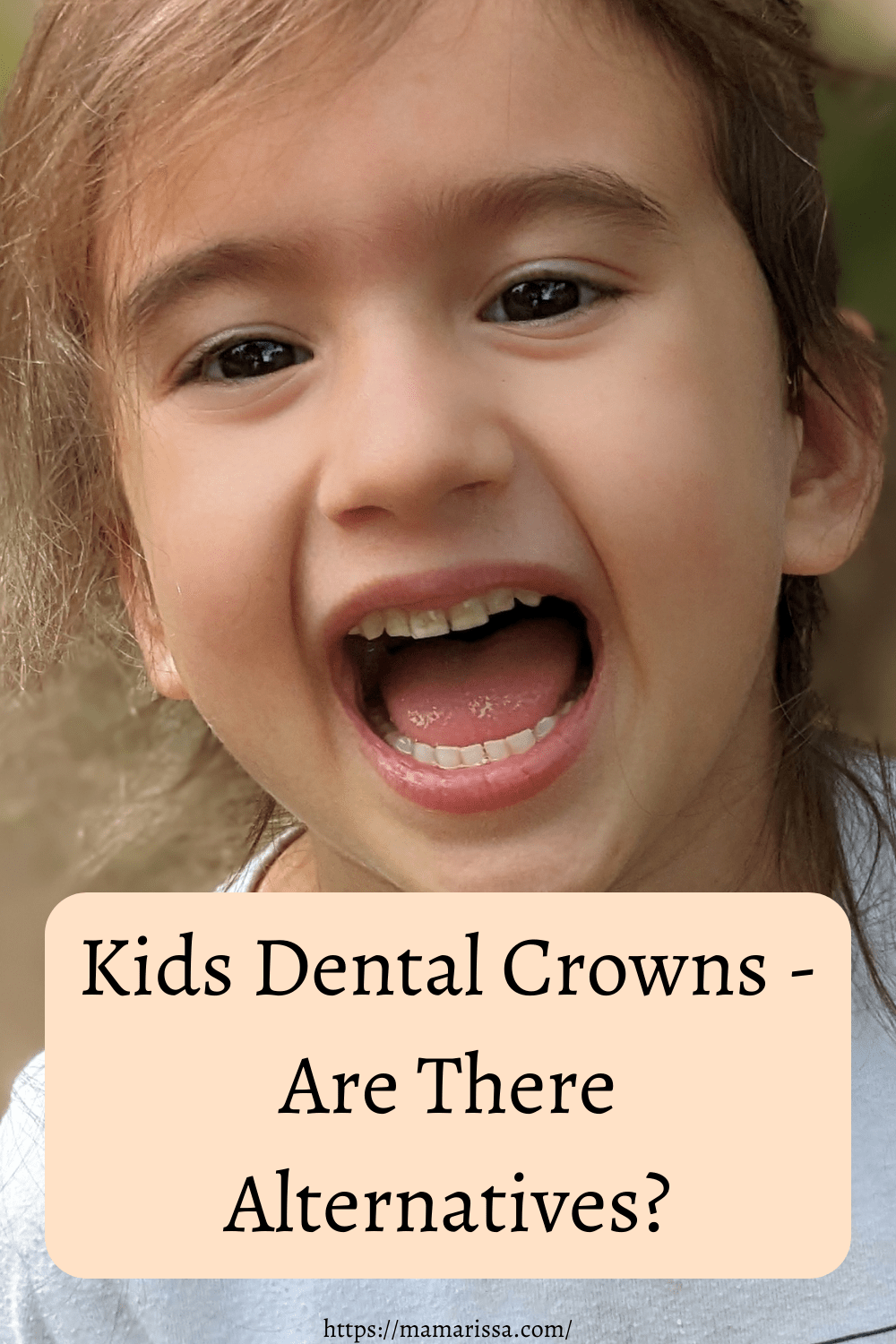

8 responses to “Kids Dental Crowns – Are There Alternatives?”
[…] Learn what to do when the dentist says your child needs dental work. […]
[…] Kids Dental Crowns – Are There Alternatives? […]
[…] Find out what to do when the dentist recommends kids dental crowns in this post. […]
[…] #2: Check out this most recent update on my daughter’s teeth 2 1/2 years after discovering the decay, and find out what your […]
[…] Update 5/11/23: Last fall, 2 1/2 years after discovering the tooth decay, my daughter got crowns and fillings on the teeth that had been damaged beyond natural repair prior to the discovery of her decay. Although her decay was still arrested and some of it had even improved, a terrible Covid-induced reflux flare-up was making her cavitated teeth very sensitive, so we went ahead and got the work done.. Read the full update in this post. […]
[…] Read about alternatives when the dentist mentions kids dental crowns in this post. […]
[…] Kids Dental Crowns – Are There Alternatives? […]
[…] her teeth have been healed of decay by completely natural means. Read my latest tooth decay update here for more info on what your options are when the dentist mentions the need for dental crowns and […]



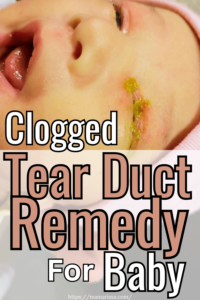





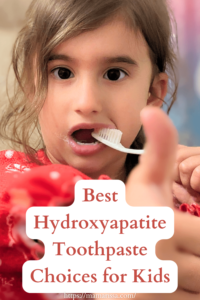
Leave a Reply